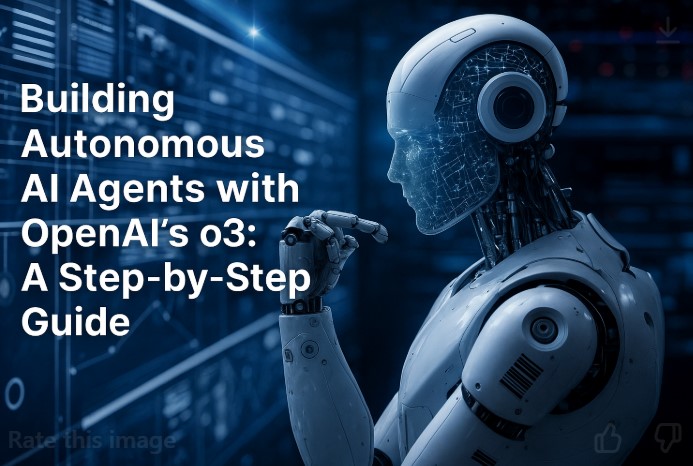
June 24, 2025
Building Autonomous AI Agents with OpenAI's o3: A Step-by-Step Guide
Building Autonomous AI Agents with OpenAI's o3: A Step-by-Step Guide
Have you pondered how to make an autonomous AI agent? One that can reason, learn, adapt, and decide? Imagine an AI system that solves complicated issues, creates multi-step solutions, and improves over time. Sound like a sci-fi movie, right?
Guess what? OpenAI's o3 model makes this possible. This blogpost will show you how to create an autonomous AI agent using o3, a sophisticated model that excels at complicated reasoning. Start making your own AI that thinks and acts autonomously!
Prerequisites and Setup
First, let's set up everything before writing code. You will need certain computer items:
- Use Python 3.9 or above.
- Use libraries such as openai, langchain, and python-dotenv.
- OpenAI account and API key for o3 model access.
Install the essential libraries first. Use your terminal to execute this:
pip install openai langchain python-dotenvGet your OpenAI API key too! Access it via your OpenAI dashboard. With that, we are ready!
Designing the Agent's Architecture
Let we discuss architecture. What makes AI autonomous? Breaking down a task into smaller bits and making decisions based on what it learns is crucial. This requires three major components:
- The Planner: Determines the agent's next logical action.
- The Executor: The agent's "hands" who execute the action.
- The Memory: Stores the agent's learnings for better decision-making.
Here's a short look at how these components work:
![]()
At every step, the agent refines its strategy depending on previous acts. You learn and adapt, like when creating a gaming strategy.
Coding the Base Agent with o3
Let's code now because we have a blueprint ready. Our agent's reasoning will be based on OpenAI's o3 model.
Set up the OpenAI client and add the API key to your script:
import os
from openai import OpenAI
client = OpenAI(api_key=os.getenv("OPENAI_API_KEY"))
Next, develop a basic task where the agent creates a three-step solution for a complicated query. You could ask it to plan global warming research:
response = client.chat.completions.create(
model="gpt-4-o", # o3 assumed alias
messages=[{"role": "user", "content": "Plan a 3-step research strategy for global warming."}]
)
print(response.choices[0].message.content)
You'll get a response like:
Step 1: Gather existing research data on global warming from trusted sources. Step 2: Analyze the impact of climate change on local ecosystems. Step 3: Develop actionable strategies for reducing carbon footprints.
Though basic, this is the foundation of your autonomous agent. The agent learns and plans depending on your task.
Looping through the reasoning process will make it smarter. This lets the agent refine its methods.
def autonomous_loop(goal):
memory = []
for _ in range(3): # simple 3-step autonomy
prompt = f"Goal: {goal}\nPrevious: {memory}\nNext step?"
response = client.chat.completions.create(
model="gpt-4-o",
messages=[{"role": "user", "content": prompt}]
)
step = response.choices[0].message.content
memory.append(step)
print(f"Step {_+1}: {step}")Based on its previous learning, this code will add additional steps to improve its understanding. More it "thinks," the wiser it becomes!
Enhancing the Agent with Memory and Context
Memory gives autonomous agents strength. Consider: When addressing an issue, your agent should not forget what it did before. Adding past actions as context for the next helps improve recall.
Instead of giving it a fresh cue, we describe prior actions:
context = "\n".join(memory[-3:]) # Grabbing the last three steps for better contextThus, the agent learns from errors and improves decision-making.
Adding Tools: Web Search or Code Execution
What if the agent has to research something? We may have the agent search the web or run code. This is where LangChain helps. Let's imagine the agent requires climate change effect data. How to set it up:
def search_tool(query):
# mocked search result
return f"Search result for '{query}': Climate change increases extreme weather."
# simulate reasoning + tool
if "search" in step.lower():
result = search_tool("impact of climate change")
memory.append(result)Agents is now able to use external tools to improve its reasoning.
Deploying with Streamlit
Want to add interactivity? Streamlit lets you design a basic UI for agent interaction. They might enter their objectives and see the agent create a strategy.
import streamlit as st
st.title("Autonomous AI Agent")
goal = st.text_input("Enter your goal:")
if goal:
autonomous_loop(goal)Streamlit makes it simple to create a web app to observe the agent.
Conclusion
Congrats! You have created an autonomous AI agent using OpenAI's o3 model! We addressed agent setup, task reasoning, memory improvement, and external tools.
We are just scraping the surface. You can improve your agent with advanced reasoning, self-reflection, and databases for long-term memory. Possibilities are unlimited!
I recommend digging further if you liked building this. Use more advanced tools, alter prompts, or integrate your agent with other APIs to boost its power. Let your imagination run free with autonomous AI!
929 views
